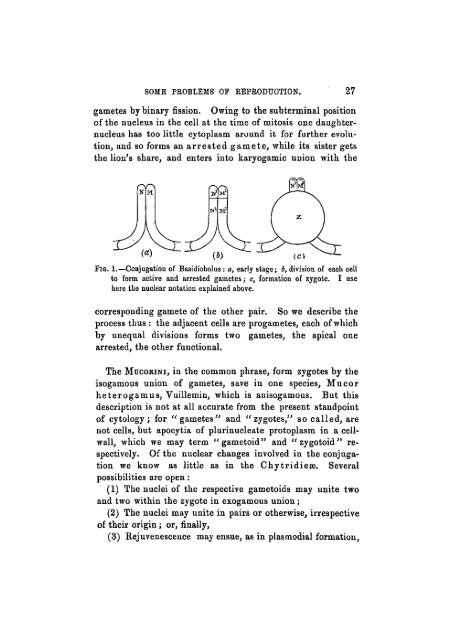Some Problems of Reproduction: a Comparative Study of ...
Some Problems of Reproduction: a Comparative Study of ...
Some Problems of Reproduction: a Comparative Study of ...
Create successful ePaper yourself
Turn your PDF publications into a flip-book with our unique Google optimized e-Paper software.
SOME PROBLEMS OF REPRODUCTION. 27<br />
gametes by binary fission. Owing to the subterminal position<br />
<strong>of</strong> the nucleus in the cell at the time <strong>of</strong> mitosis one daughternucleus<br />
has too little cytoplasm around it for further evolution,<br />
and so forms an arrested gamete, while its sister gets<br />
the lion's share, and enters into karyogamic union with the<br />
(5) (O<br />
FIG. 1.— Conjugation <strong>of</strong> Basidiobolus : a, early stage; b, division <strong>of</strong> each cell<br />
to form active and arrested gametes; c, formation <strong>of</strong> zygote. I use<br />
here the nuclear notation explained above.<br />
corresponding gamete <strong>of</strong> the other pair. So we describe the<br />
process thus : the adjacent cells are progametes, each <strong>of</strong> which<br />
by unequal divisions forms two gametes, the apical one<br />
arrested, the other functional.<br />
The MTJCORINI, in the common phrase, form zygotes by the<br />
isogamous union <strong>of</strong> gametes, save in one species, Mucor<br />
heterogamus, Vuillemin, which is anisogamous. But this<br />
description is not at all accurate from the present standpoint<br />
<strong>of</strong> cytology; for "gametes" and "zygotes," so called, are<br />
not cells, but apocytia <strong>of</strong> plurinucleate protoplasm in a cellwall,<br />
which we may term "gametoid" and "zygotoid" respectively.<br />
Of the nuclear changes involved in the conjugation<br />
we know as little as in the Chytridiese. Several<br />
possibilities are open:<br />
(1) The nuclei <strong>of</strong> the respective gametoids may unite two<br />
and two within the zygote in exogamous union;<br />
(2) The nuclei may unite in pairs or otherwise, irrespective<br />
<strong>of</strong> their origin ; or, finally,<br />
(3) Rejuvenescence may ensue, as in plasraodial formation,

















